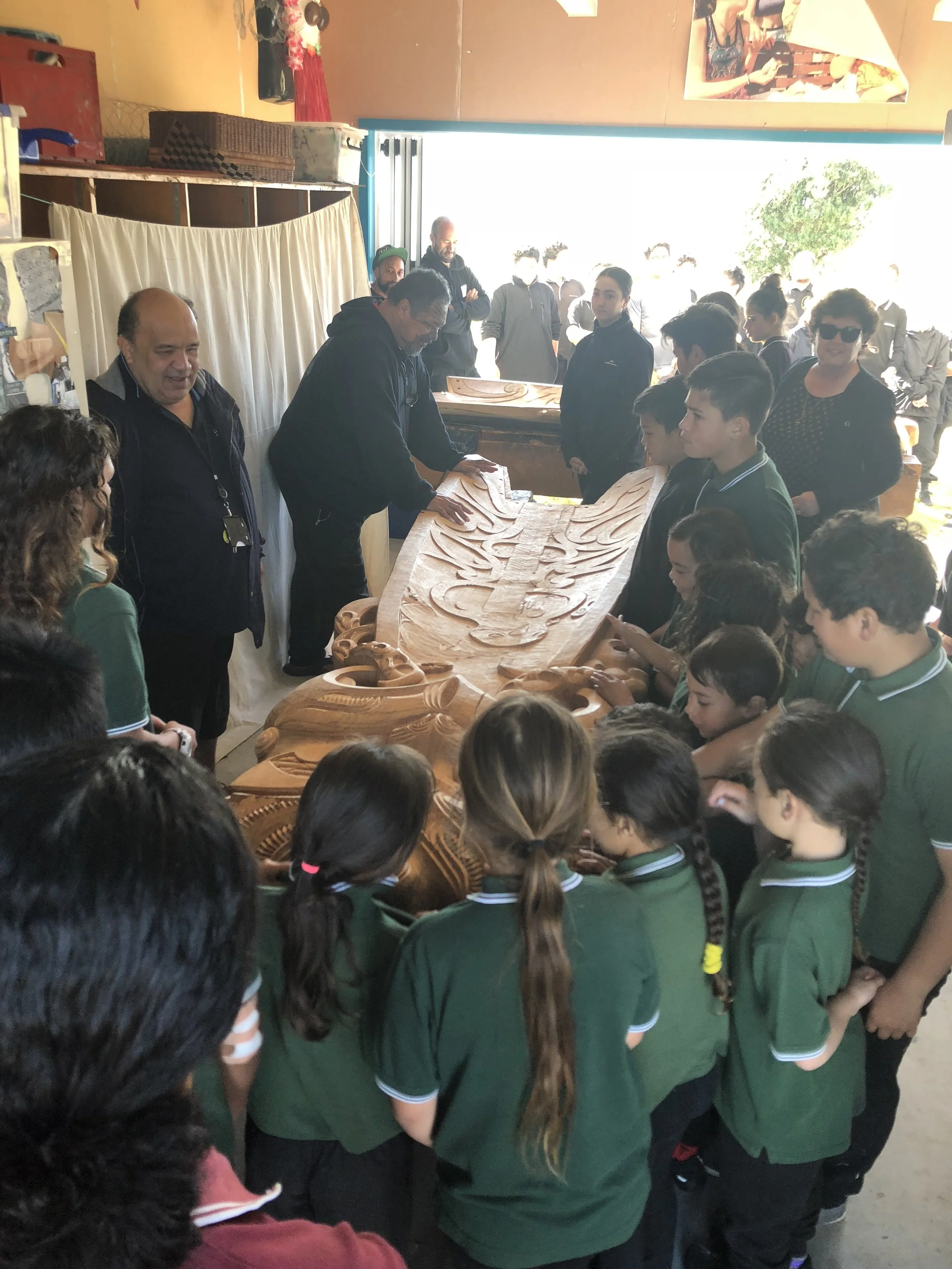Te Aitanga a Hauiti in front of the present-day site of Te Whare Wananga o Te Rawheoro, Uawa.
History of Hingangaroa, Iranui
and Te Whare Wānanga o Te Rawheoro
Hingangaroa and Iranui are two prominent ancestors from whom many people can trace their descent. This includes Te Whanau a Apanui (through the eldest son Taua), Ngati Porou (through Mahaki Ewe Karoro), and Te Aitanga a Hauiti who trace their lineage from the youngest son, Hauiti.
Iranui was the sister of Kahungunu. She and her brother had travelled from the north. Iranui met Hingangaroa and remained in Uawa, and her brother carried on further south. At a hui in Whakakī, Iranui demonstrated the concept of haumi waka with her husband Hingangaroa. This is the joining of two parts to make a single waka, as the joining of two people. It is this demonstration that is presented in this whakairo of Hingangaroa me Iranui.
Te Whare Wānanga o Te Rawheoro was the traditional Māori university of learning established by Hingangaroa around the 15th century. In verse six of Te Tangi a Rangiuia ki tana tama ki a Tuterangiwhaitiri (the lament by Rangiuia), Rangiuia gives the following definitive statement of the establishment and existence of Te Whare Wānanga o Te Rawheoro. He acknowledges Hingangaroa as the architect of Te Rawheoro as a learning institution:
“Ko Tataiarorangi,
ko Te Huapae ra,
ko Te Rangihopukia, ko Hinehuhuritai,
me ko Manutangirua, ko Hingangaroa.
Ka tu tona whare Te Rawheoro e.
Ka tipu te whaihanga e hika ki Uawa”.
The translation for this statement is thus:
“Tataiarorangi
had Te Huapae
Te Rangihopukia
had Hinehuhuritai
Manutangirua
had Hingangaroa
He it was who established the house Te Rawheoro,
And the art’s flourished, my son, in Uawa”.
In addition, Sir. Apirana Ngata (1930: 25) writes:
“Ko te whare wananga whai mana tenei o te pito whakararo o Te Tairawhiti, a, ki te titiro iho ki nga tohunga o Wairarapa, kua tuhia nei a ratau korero e Te Whatahoro, ko te whare whaimana tera o Te Tairawhiti katoa.”
“This was the prominent house of learning on the southern end of the Tairawhiti, and if you research the writings of the learned of the Wairarapa, their thoughts having been scribed by Te Whatahoro, this was the most important house of learning in all of the Tairawhiti.”
The traditions of Te Rawheoro passed to the house of Ruapekapeka that once stood beside the Uawa river and along with the house of Te Ruakaka, were the primary sources of traditional education in Uawa up until Rangiuia’s death around about the mid-1800’s. Both the Taowaru and the Manaia patterns used in carving originated from Te Rawheoro.
Nā Victor Walker me Hine Te Ariki Parata-Walker enei kōrero.
To read more about the Hingangaroa me Iranui whakairo, see Part 1 →
Te Aitanga a Hauiti Centre of Excellence and Te Ahikā thank:
Toi Maori, Mark Kopua, Jack Brooking, Tolaga Bay Area School & Kahukuranui, nga marae o Te Aitanga a Hauiti, Eastland Community Trust, Chorus, Te Puni Kokiri, Gisborne District Council, and Kingsbeer Architecture.



